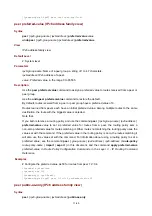
11-30
short-cut
: If the keyword is specified for an eBGP route, the route will use the local routing
management value rather than that of eBGP routes, so the preference of the route is reduced.
route-policy-name
: Name of a routing policy, a string of 1 to 19 characters.
Description
Use the
network
command to advertise a network to the IPv6 BGP routing table.
Use the
undo network
command to remove an entry from the IPv6 BGP routing table.
By default, no route is advertised.
Note that:
z
The route to be advertised must exist in the local IP routing table, and using a routing policy
makes route management more flexible.
z
The route advertised to the BGP routing table using the
network
command has the IGP origin
attribute.
Examples
# Advertise the network 2002::/16 into the IPv6 BGP routing table.
<Sysname> system-view
[Sysname] bgp 100
[Sysname-bgp] ipv6-family
[Sysname-bgp-af-ipv6] network 2002:: 16
peer advertise-community (IPv6 address family view)
Syntax
peer
{
group-name
|
ipv4-address
|
ipv6-address
}
advertise-community
undo peer
{
group-name
|
ipv4-address
|
ipv6-address
}
advertise-community
View
IPv6 address family view
Default Level
2: System level
Parameters
group-name
: Name of an IPv4 or IPv6 peer group, a string of 1 to 47 characters.
ipv4-address
: IPv4 address of a peer.
ipv6-address
: IPv6 address of a peer.
Description
Use the
peer advertise-community
command to advertise the community attribute to a peer/peer
group.
Use the
undo peer advertise-community
command to remove the configuration.
By default, no community attribute is advertised to any peer group/peer.
Examples
# Advertise the community attribute to the peer 1:2::3:4.
<Sysname> system-view
[Sysname] bgp 100
















































